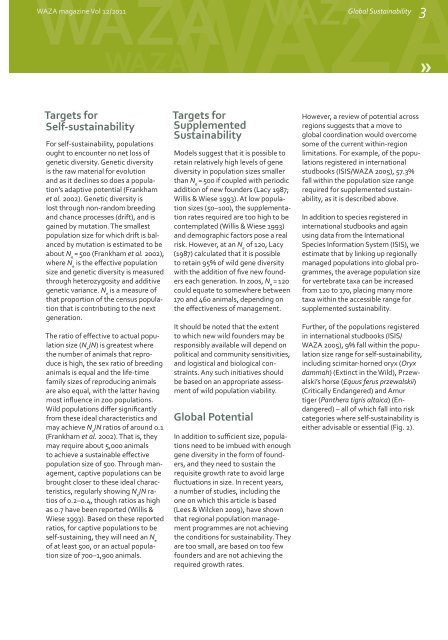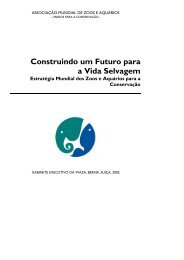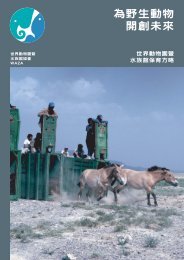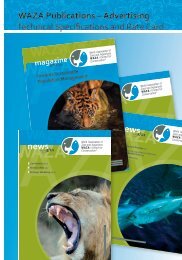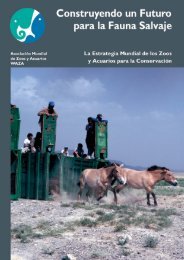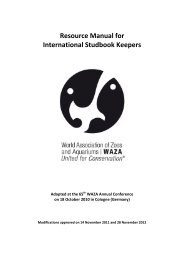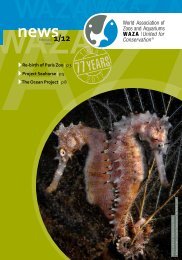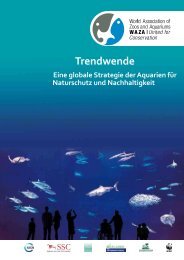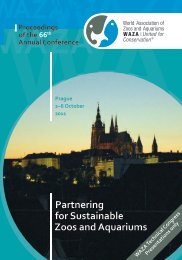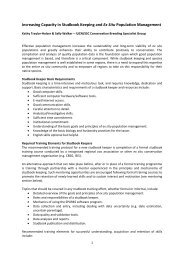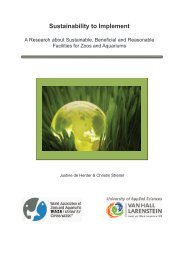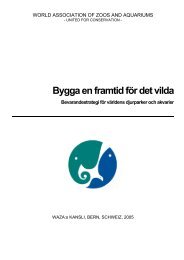Towards Sustainable Population Management - Waza
Towards Sustainable Population Management - Waza
Towards Sustainable Population Management - Waza
Create successful ePaper yourself
Turn your PDF publications into a flip-book with our unique Google optimized e-Paper software.
WAZA magazine Vol 12/2011<br />
Targets for<br />
Self-sustainability<br />
For self-sustainability, populations<br />
ought to encounter no net loss of<br />
genetic diversity. Genetic diversity<br />
is the raw material for evolution<br />
and as it declines so does a population’s<br />
adaptive potential (Frankham<br />
et al. 2002). Genetic diversity is<br />
lost through non-random breeding<br />
and chance processes (drift), and is<br />
gained by mutation. The smallest<br />
population size for which drift is balanced<br />
by mutation is estimated to be<br />
about N e = 500 (Frankham et al. 2002),<br />
where N e is the effective population<br />
size and genetic diversity is measured<br />
through heterozygosity and additive<br />
genetic variance. N e is a measure of<br />
that proportion of the census population<br />
that is contributing to the next<br />
generation.<br />
The ratio of effective to actual population<br />
size (N e /N) is greatest where<br />
the number of animals that reproduce<br />
is high, the sex ratio of breeding<br />
animals is equal and the life-time<br />
family sizes of reproducing animals<br />
are also equal, with the latter having<br />
most influence in zoo populations.<br />
Wild populations differ significantly<br />
from these ideal characteristics and<br />
may achieve N e /N ratios of around 0.1<br />
(Frankham et al. 2002). That is, they<br />
may require about 5,000 animals<br />
to achieve a sustainable effective<br />
population size of 500. Through management,<br />
captive populations can be<br />
brought closer to these ideal characteristics,<br />
regularly showing N e /N ratios<br />
of 0.2–0.4, though ratios as high<br />
as 0.7 have been reported (Willis &<br />
Wiese 1993). Based on these reported<br />
ratios, for captive populations to be<br />
self-sustaining, they will need an N e<br />
of at least 500, or an actual population<br />
size of 700–1,900 animals.<br />
Targets for<br />
Supplemented<br />
Sustainability<br />
Models suggest that it is possible to<br />
retain relatively high levels of gene<br />
diversity in population sizes smaller<br />
than N e = 500 if coupled with periodic<br />
addition of new founders (Lacy 1987;<br />
Willis & Wiese 1993). At low population<br />
sizes (50–100), the supplementation<br />
rates required are too high to be<br />
contemplated (Willis & Wiese 1993)<br />
and demographic factors pose a real<br />
risk. However, at an N e of 120, Lacy<br />
(1987) calculated that it is possible<br />
to retain 95% of wild gene diversity<br />
with the addition of five new founders<br />
each generation. In zoos, N e = 120<br />
could equate to somewhere between<br />
170 and 460 animals, depending on<br />
the effectiveness of management.<br />
It should be noted that the extent<br />
to which new wild founders may be<br />
responsibly available will depend on<br />
political and community sensitivities,<br />
and logistical and biological constraints.<br />
Any such initiatives should<br />
be based on an appropriate assessment<br />
of wild population viability.<br />
Global Potential<br />
In addition to sufficient size, populations<br />
need to be imbued with enough<br />
gene diversity in the form of founders,<br />
and they need to sustain the<br />
requisite growth rate to avoid large<br />
fluctuations in size. In recent years,<br />
a number of studies, including the<br />
one on which this article is based<br />
(Lees & Wilcken 2009), have shown<br />
that regional population management<br />
programmes are not achieving<br />
the conditions for sustainability. They<br />
are too small, are based on too few<br />
founders and are not achieving the<br />
required growth rates.<br />
Global Sustainability<br />
However, a review of potential across<br />
regions suggests that a move to<br />
global coordination would overcome<br />
some of the current within-region<br />
limitations. For example, of the populations<br />
registered in international<br />
studbooks (ISIS/WAZA 2005), 57.3%<br />
fall within the population size range<br />
required for supplemented sustainability,<br />
as it is described above.<br />
In addition to species registered in<br />
international studbooks and again<br />
using data from the International<br />
Species Information System (ISIS), we<br />
estimate that by linking up regionally<br />
managed populations into global programmes,<br />
the average population size<br />
for vertebrate taxa can be increased<br />
from 120 to 170, placing many more<br />
taxa within the accessible range for<br />
supplemented sustainability.<br />
Further, of the populations registered<br />
in international studbooks (ISIS/<br />
WAZA 2005), 9% fall within the population<br />
size range for self-sustainability,<br />
including scimitar-horned oryx (Oryx<br />
dammah) (Extinct in the Wild), Przewalski’s<br />
horse (Equus ferus przewalskii)<br />
(Critically Endangered) and Amur<br />
tiger (Panthera tigris altaica) (Endangered)<br />
– all of which fall into risk<br />
categories where self-sustainability is<br />
either advisable or essential (Fig. 2).<br />
3<br />
»


